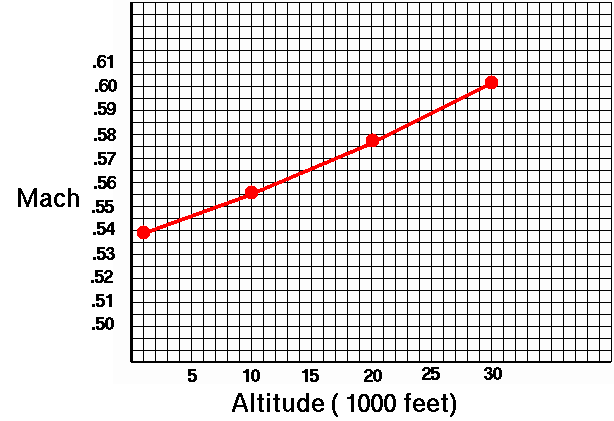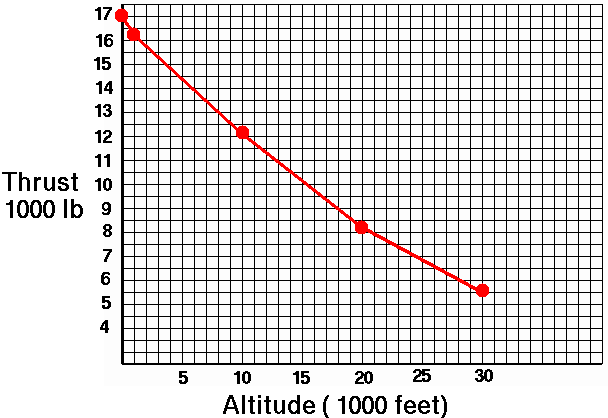
|

|
+ Text Only Site
+ Non-Flash Version
+ Contact Glenn
|
|
|

|
Propulsion System Analysis
Answers
|

|
- Why do different aircraft have different types of
propulsion systems?
Different propulsion systems produce thrust in different ways. Some ways are
more fuel efficient than others. Depending on the mission of the aircraft,
a certain propulsion system is better suited for a given aircraft. High thrust
aircraft typically have worse fuel economy than low thrust (cruise) aircraft.
- When would you use a ramjet
on an airplane?
For very high speed aircraft, access to space, or hypersonic cruise.
- Find the Mach number
for a subsonic airplane flying at 650 mph.
|
|
M = Mach
|
|
M = V/A
|
V = Air Velocity
|
|
M
=.85
|
A = 762 mph (speed of sound)
|
|
|
V = 650 mph
|
- Find the Mach number for a subsonic airplane flying at 525 mph.
M = 525 mph/762 mph =
.69
- Find the Mach number for a suubsonic airplane flying at 725
mph.
M = 725 mph/762 mph =
.95
- Find the velocity of a subsonic airplane flying at Mach number
of .65.
|
M =V/A
|
M = Mach
|
|
.65 = V/762
|
V = Air Velocity
|
|
V = 495.3
mph
|
A = 762 mph. (speed of sound)
|
- Find the velocity of a subsonic airplane flying at Mach number
of .80.
M = V/A
.8 = V/762
V = 609.6 mph
- Find the velocity of a supersonic airplane flying at Mach number
of 1.5.
M = V/A
V = M * A = 1.5 * 762
V = 1143 mph
- Using the interactive
Atmosphere Calculator,
find the speed of sound, pressure and temperature at the following
altitudes using English Units.
|
ALTITUDE
|
SOUND SPEED
|
PRESSURE
|
TEMPERATURE
|
|
1,000 ft.
|
1113
|
14.17
|
55
|
|
5,000 ft.
|
1097
|
12.23
|
41
|
|
10,000 ft.
|
1077
|
10.11
|
23
|
|
20,000 ft.
|
1037
|
6.76
|
-12
|
|
25,000 ft.
|
1016
|
5.46
|
-30
|
|
30,000 ft.
|
995
|
4.37
|
-47
|
- Produce three graphs from the data recorded above, showing
speed of sound, pressure, and temperature versus altitude.



- What effect does altitude have on the speed of sound?
The speed of sound decreases
with increasing altitude.
- What effect does altitude have on pressure?
The atmospheric pressure decreases
with increasing altitude.
- What effect does altitude have on temperature?
The atmospheric temperature decreases
with increasing altitude.
- Flying at a constant speed of 600 feet per second, find the speed of
sound and the Mach number at the following altitudes.
|
ALTITUDE
|
SOUND SPEED
|
MACH NUMBER
|
|
1,000 ft.
|
1113
|
.539
|
|
10,000 ft.
|
1077
|
.556
|
|
20,000 ft.
|
1037
|
.578
|
|
30,000 ft.
|
995
|
.602
|
- Graph the changes in Mach Number
at the different altitudes.

- How does the change in altitude affect Mach Number when
flying at a constant speed?
The Mach number increases
with increasing altitude for the same speed.
- The thrust of a jet engine is also affected by changes in altitude.
Calculate the thrust of a Pratt & Whitney JT8D-17 jet engine (17,000 pounds at sea level)
at different altitudes using the temperature and pressure results
from Question 9, and the following equation:
|
|
|
|
|
|
|
|
|
F = thrust at altitude
|
|
|
|
|
|
|
|
|
|
F sl = sea level static thrust at
takeoff (17,000 pounds)
|
|
|
|
|
|
|
|
|
|
P = static pressure at
altitude
|
|
|
|
|
|
|
|
|
|
P sl = sea level static pressure (14.7
psi)
|
|
F
|
=
|
F sl
|
x
|
P/P sl
|
x
|
sqrt(T sl/T)
|
|
T = absolute temp(temp + 460) at altitude
|
|
|
|
|
|
|
|
|
|
T sl = sea level absolute temperature
(520 R)
|
|
ALTITUDE
|
PRESSURE
|
TEMPERATURE
|
factor
|
THRUST
(psi)
|
|
1000 ft.
|
14.17
|
515
|
.97
|
16490
|
|
10,000 ft.
|
10.11
|
483
|
.71
|
12070
|
|
20,000 ft.
|
6.76
|
448
|
.49
|
8330
|
|
30,000 ft.
|
4.37
|
413
|
.33
|
5610
|
- Graph the change in thrust with altitude for the Pratt &
Whitney JT8D-17 jet engine.

- Give your conclusions on thrust and flying at different
altitudes.
Thrust will decrease with the change
in higher altitude.
|
Related Pages:
Standards
Activity
Worksheet
Propulsion Activity Index
Propulsion Index
|
|
|
|
